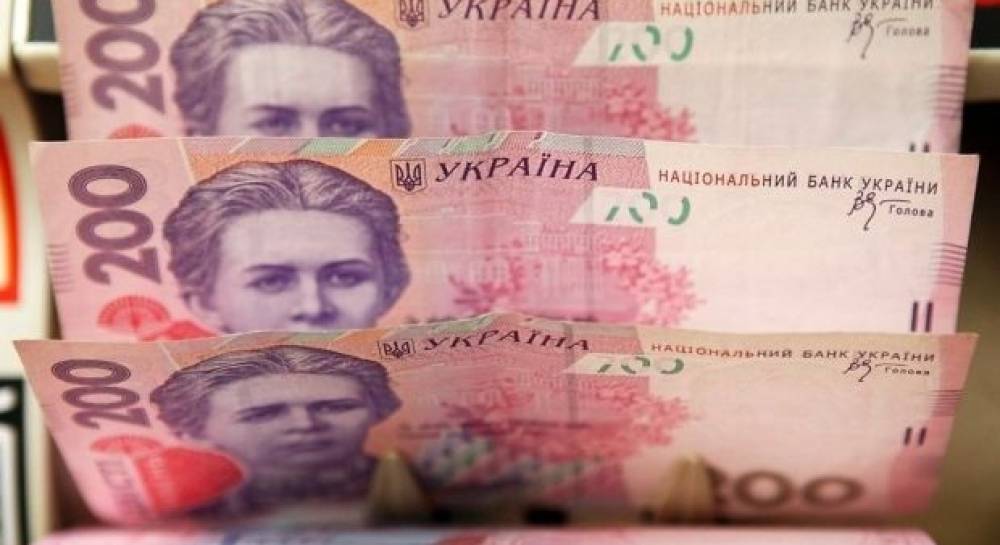
Ukraine-Macroeconomic situation – June 2014
Political unrest shifted to eastern Ukraine over April-May 2014 as armed pro-Russian rebels took control over large territories in Luhansk and Donetsk oblasts, leading to clashes with Ukraine’s military forces...
ANALYTICAL REPORT: by Olga Pogarska, Edilberto L. Segura
SigmaBleyzer private equity firm & The Bleyzer Foundation (TBF), Kyiv, Ukraine
Published by U.S.-Ukraine Business Council (USUBC)
SUMMARY POINTS
· Political unrest shifted to eastern Ukraine over April-May 2014 as armed pro-Russian rebels took control over large territories in Luhansk and Donetsk oblasts, leading to clashes with Ukraine’s military forces.
· Mr. Petro Poroshenko, a successful businessman and an experienced politician, won the presidential election outright in the first round held on May 25th. His election is seen as an important step towards restoring Ukraine’s unity and resolving the difficult situation in eastern Ukraine. Although Poroshenko is a pro-Western politician, he is believed to be someone who can begin to normalize relations with Russia.
· Real GDP declined by 1.1% yoy in 1Q 2014 and is forecast to fall by 5% yoy in 2014 due to weak export performance, fiscal austerity and low bank lending activity.
· Unlike other sectors, agriculture maintained 5% yoy growth over January-April 2014. Despite unrest in eastern oblasts, funding constraints and rising production costs, the spring sowing campaign was on its way. Given favorable weather conditions, the grain harvest is expected to be around 60 million tons.
· As anticipated, tax revenues declined in the first four months of 2014. But thanks to the large NBU profit transfer and expenditure adjustment, the state budget deficit was 57% yoy lower for the period.
· Despite improvement in the state budget balance, the overall fiscal deficit forecast was worsened to 7% of GDP for 2014 due to higher Naftogaz imbalances as scheduled tariff increases for the population and heating companies will not compensate for the Hryvnia devaluation and higher imported natural gas prices.
· Russia raised natural gas prices for Ukraine from $268.5 per 1000 m3 in 1Q 2014 to $485 per 1000 m3 in April. Ukraine’s refusal to accept this price resulted in a new gas dispute with Russia. With the failure of negotiations failed, Russia cut gas supplies to Ukraine on June16. Ukraine still has some time until mid-autumn to settle the issue.
· Consumer price inflation accelerated to 10.9% yoy in May and is forecast to reach 16% yoy at the end of 2014.
· Commercial banks continued to be under stress amid ongoing deposit outflows and likely capital deterioration.
· The Hryvnia exchange rate showed signs of stabilization in May/June. We maintain our forecast of Hryvnia exchange rate at about UAH 11.5 per USD through the rest of 2014 and 2015.
· In May, Ukraine received the first disbursements from the IMF, other international organizations as well as individual countries, which eased Ukraine’s financing concerns.
· In April, Ukraine’s foreign trade balance switched into surplus, primarily on account of a sharp import decrease as exports remained weak. The current account deficit is forecast to narrow from 9% of GDP in 2013 to around 5% of GDP in 2014.
Forecast of Main Macroeconomic Indicators for 2014-2015
2011 | 2012 | 2013 | 2014 (F) | 2015 (F) | |
GDP, $ billion | 163.4 | 176.6 | 182.0 | 142.9 | 158.0 |
Real GDP Growth, % yoy | 5.2 | 0.2 | 0.0 | -5.0 | 1.5 |
Private Consumption, real growth, % yoy | 15.0 | 11.7 | 7.8 | -6.0 | 2.0 |
Fiscal Balance, incl. Naftogaz and Pension Fund, % of GDP | -4.3 | -6.0 | -6.5 | -7.0 | -4.5 |
Public Debt, % of GDP | 36.3 | 36.6 | 40.5 | 55.0 | 59.0 |
Consumer Inflation, eop, % yoy | 4.6 | -0.2 | 0.5 | 16.0 | 8.0 |
Hryvnia Exchange Rate per USD, eop | 8.0 | 8.0 | 8.0 | 11.0-11.5 | 11.5 |
Current Account Balance, % of GDP | -6.3 | -8.1 | -9.0 | -5.0 | -4.0 |
Export of Goods and Services, $ billion | 88.8 | 90.0 | 85.3 | 75.0 | 84.5 |
Import of Goods and Services, $ billion | 99.0 | 104.4 | 100.8 | 82.0 | 91.0 |
FDI ($ billion) | 7.0 | 6.6 | 3.3 | 3.0 | 5.0 |
International Reserves ($ billion) | 31.8 | 24.5 | 20.4 | 16.0 | 18.0 |
External Debt ($ billion) | 126.2 | 135.1 | 142.5 | 149.0 | 157.0 |
POLITICAL DEVELOPMENTS
Following the ouster of President Yanukovych in February 2014, the return of the 2004 Constitution and a call for early presidential elections on May 25th, the situation in Kyiv(the capital of Ukraine) has calmed, but unrest has erupted in the southern and eastern regions of Ukraine. Started as pro-Russian demonstrations (and against Kyiv’s new pro-Western leaders), they quickly evolved into armed insurgency with the rebels seizing control over strategic buildings, such as city administrations, police and state security offices and TV stations.
At the same time, given the population’s relatively low support for a union between Ukraine and Russia or for federalization of the country (Russia’s preferred scenario for Ukraine that would allow increased Russian influence over the country), the protests localized in two oblasts of Ukraine – Donetsk and Luhansk. Supported by Russian Special Forces, the rebels took control of large territories of the region, proclaimed the creation of ‘independent’ Donetsk and Luhansk People’s Republics and held local referendums on May 11th, not recognized by either Ukrainian authorities or the international community, including Russia.
To restore order within its borders, the Ukrainian government has started a military campaign against the separatist rebels. Restrained by the risk of Russian military invasion into mainland Ukraine and taken by surprise by the how well equipped and trained the separatists are, Ukrainian forces have had mixed results so far. The continuing armed clashes in the region and the rebels’ threat to disrupt voting in towns and cities of their control hampered voting in those regions.
However, scarce voting in these two oblasts did not prevent the international community from recognizing the elections as being free and fair, the election results and, hence, the future President’s legitimacy.
According to election results, Petro Poroshenko, a billionaire chocolate manufacturer and an experienced politician (previously served as the Minister of Foreign Affairs of Ukraine, the Minister of Economy and Trade and the Head of the National Security Council), received 54.7% of the vote. This made him the winner without forcing the runoff scheduled for June 15th. Mr. Poroshenko is considered a person who can work with both the West and the East.
Pledging to sign the economic part of the Association Agreement with the EU and strongly backing closer ties with the EU, he also stands for normalization of relations with Russia, ‘a vital Ukrainian partner’. Furthermore, Mr. Poroshenko has received strong support from both eastern and western parts of Ukraine and declared that his first trip would be to the Donbas region. In this respect, his election as President of Ukraine is considered an important step towards restoring Ukraine’s unity and resolving the rebellion in the industrial east of Ukraine.
In addition to conflict in the east and uneasy relations with Russia, the new President will have to deal with a number of economic challenges faced by the country. With the economy back in recession in 1Q 2014, the national currency depreciated by about 43% since the beginning of the year and strained public finances. The new President is expected to demonstrate strong political will to implement tough economic restructuring and painful reforms to restore economic stability, reduce corruption and overcome years of mismanagement.
According to the re-introduced 2004 constitution, the President shares duties with the parliament and Prime Minister. To be able to implement his election promises and these painful reforms, Mr. Poroshenko will have to call snap parliamentary elections to secure sufficient influence in the Ukrainian parliament, which still has many allies of former President Yanukovych. Poroshenko has already signaled early parliamentary elections may be called before the end of 2014.
In the meantime, Mr. Poroshenko announced that Arseniy Yatseniuk would keep his post as Prime Minister, praising him for securing a two-year $17 billion IMF loan agreement, which would unlock an additional $15 billion from the EU, the World Bank and a number of individual countries. The IMF board approved the loan at the end of April with an immediate disbursement of $3.2 billion.
Following the IMF agreement, Ukraine reached a $1 billion 5-year bond deal with the US (securities are backed by the US government), received the first tranche of the EU macro-financial assistance loan worth €1.6 billion in total and signed $1.48 billion worth of loan agreements with the World Bank.
These funds will help ease Ukraine’s external financing and fiscal needs in 2014 and 2015 and have already favorably affected Ukraine’s foreign exchange market. In addition, an economic restructuring program attached to the IMF loan, although tough and painful in the short-term, will reduce Ukraine’s Balance-of-Payments and Fiscal vulnerabilities and will set grounds for the country to achieve fast rates of economic growth over the medium and long-term.
ECONOMIC GROWTH
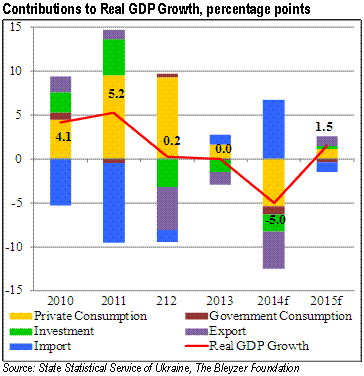
Due to months of political turmoil and related uncertainty, sharp Hryvnia depreciation, disrupted trade relations with Russia and tough fiscal austerity measures, Ukraine’s real GDP is forecast to decline by about 5% yoy in 2014 (including Crimea). The slight downward revision is attributed to the prolonged unrest in the eastern oblasts of Ukraine.
At the same time, given the commitment of top Ukrainian officials to implement painful but needed economic reforms, including restructuring the energy sector, reducing corruption and allowing fiscal decentralization, the economy is expected to stabilize throughout the second half of 2014, return to growth in 2015 and achieve its growth potential over the medium-term.
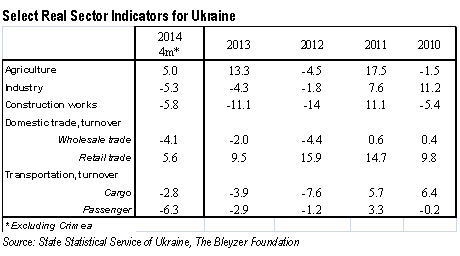
In 1Q 2014, real GDP fell by 1.1% yoy, according to the State Statistics Service of Ukraine. The decline is expected to deepen over the coming quarters as political unrest has shifted to the industrial eastern oblasts of Ukraine, the impact of fiscal austerity measures has yet to start being felt in 2Q 2014, and there is little chance of quick foreign trade improvements.
At the same time, favorable weather conditions support a positive outlook for this year’s crop, despite funding constraints experienced by many farmers during the spring sowing campaign. Although the harvest is likely to be lower than last year’s record, thanks to agriculture the economy may perform better in the last quarter of the year.
With a large number of industrial enterprises concentrated in Donetsk and Luhansk, these oblasts account for about 16% of Ukraine’s GDP and almost 30% of total industrial output production.[1] As pro-Russian insurgents captured control over a number of cities and towns in the region during March-May, including Donetsk and Luhansk, economic activity in the oblasts was seriously undermined.
At the same time, strengthened foreign demand for iron ore in April and higher domestic demand for internally produced fossil fuels amid growing uncertainties over energy supplies from Russia helped soften the decline in this rich mining region. Thus, industrial production was down by 13.2% yoy and 0.8% yoy in Donetsk and Luhansk oblasts in April, respectively, contributing to an overall decrease of 6% yoy for Ukraine (excluding Crimea). While April’s data was somewhat better than for March, violent clashes between Ukrainian military and rebels during May and June are likely to deepen the social and economic crisis in the region, exerting a significant toll on the overall Ukrainian economy.
Political uncertainty, armed confrontation in the eastern regions of Ukraine, Hryvnia depreciation, and the announced tough fiscal austerity measures have started to weigh on household consumption and spending, rattled business confidence and undermined investments. In particular, retail sales turnover, often used to gauge private consumption, sank by 5% yoy in April according to the State Statistical Service of Ukraine, down from 4.7% yoy growth reported for 1Q 2014.
For the first time since 2009, real wages went down by almost 2% yoy in April. Hryvnia depreciation, announced utility tariff increases and fiscal austerity measures are forecast to further depress the population’s purchasing power and adversely affect households’ propensity to consume.
Successful presidential elections are seen as an encouraging sign of crisis resolution in Ukraine. However, restoring both foreign and domestic investor confidence will take time and will crucially depend on the first steps of the new President. In his inauguration speech, Mr. Poroshenko promised to end the violence in country’s east, underlined the importance of the unity of Ukraine, confirmed the course towards closer ties with the EU and dismissed the idea of federalization of Ukraine advocated by Russia.
Although the outlined plan for peace does not provide a clear answer of how and how quickly the violence in the east will be stopped, it seems Poroshenko’s call for dialogue and peace has received positive responses both inside and outside the country. In the meantime, domestic capital investments were down by 23% yoy over January-March 2014, according to State Statistical Service of Ukraine, while the outflow of foreign direct investments amounted to almost $1 billion on a net basis for the first four months of 2014, according to NBU preliminary Balance-of-Payments data.
Heavily dependent on capital investments, construction output indices reported a 5.8% yoy decline over January-April 2014. A relatively moderate decrease may be attributed to the presence of significant time lags in the sector. For that reason, we expect further worsening of the sector’s performance in the coming months. Already in April, construction activity dropped by almost 25% yoy.
Slumps in industrial activity, private consumption and foreign trade exerted a toll on wholesale trade and transportation sector performance. Indeed, according to early NBU data, exports and imports of goods fell by 8.3% yoy and 21.6% yoy, respectively, in US Dollar terms. As a result, wholesale trade and cargo transportation turnover sank by 4.1% yoy and 2.8% yoy, respectively, over January-April 2014. In addition, due to Russia’s annexation of Crimea and confrontations in eastern regions of Ukraine, passenger turnover fell by 6.3% yoy over the period.
Unlike other sectors, agriculture maintained momentum with output growth standing at a solid 5% yoy over January-April 2014. Some deceleration from about 6% yoy in 1Q 2014 was fully anticipated given the high base effect of the previous year. The outlook for the 2014 grain harvest remains positive despite conflict in the eastern oblasts of Ukraine, the lack of financing available for sowing and Hryvnia depreciation.
Winter crops are currently in good condition thanks to favorable weather. Although production costs have soared, the spring crop sowing campaign has been going at the usual pace. In addition, in Donetsk and Luhansk oblasts, which account for about 8% of gross value added in the agricultural sector, the ongoing unrest has had limited impact on spring sowing. Given all this, Ukraine may collect about 60 million tons of grains this year, which will be on par with the previous year’s record.
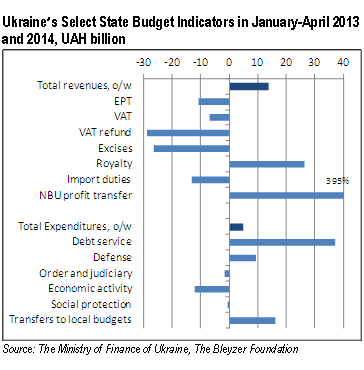
FISCAL POLICY
Due to the continuing confrontation in the eastern regions of Ukraine, lower economic growth and Hryvnia depreciation, we have revised our public sector fiscal deficit to 7% of GDP for 2014. The worsening of the public finance balance will be mainly attributed to the higher Naftogaz deficit, as the planned increase in natural gas tariffs to the population and heating companies will not outweigh the 43% Hryvnia depreciation since the beginning of the year. Moreover, the fiscal deficit forecast may be further revised upwards in case the current negotiations on the price of natural gas imports are unsuccessful.
As anticipated, due to political unrest, weak economic growth and the significant amount of taxes collected in advance in 2013, tax collections to the state budget for January-April 2014 fell compared to the same period last year. In particular, receipts from corporate profit tax, VAT, excises and import duties, which together account for about 2/3 of total state budget proceeds, were down by 10.7% yoy, 7% yoy, 26.4% yoy and 13.3% yoy in nominal terms, respectively.
At the same time, thanks to higher royalty receipts and almost 5 times larger NBU transfer of profits, total state budget revenues were up by 13.6% yoy. In addition, an almost 30% yoy decline in VAT refunds, due to weak exports, also contributed to the increase. As the 2014 budget amendments, including an increase in select taxes, took effect only at the beginning of April, tax proceeds may somewhat improve in the coming months.
The impact of fiscal austerity measures on the expenditure side of the state budget has been felt already since March. In particular, economic expenditures dropped by 12% yoy over January-April, while spending on social protections was down by 0.5% yoy. A downward adjustment of budget financing of social programs was observed for the first time since 2009.
The ongoing conflict in eastern oblasts of Ukraine as well as the risk of Russia’s intervention into these oblasts prompted higher budget spending on military defense, which was up by 9.3% yoy over the period. In addition, due to high public debt repayments as well as Hryvnia devaluation, expenditures on public debt service rose by 37% yoy compared to January-April 2013.
With total budget revenue growth outpacing expenditures, the period’s budget deficit stood at about UAH 7 billion, which is almost 57% yoy lower than last year. Despite anticipated improvements in the state budget balance thanks to tough fiscal austerity measures, the overall public sector fiscal balance is forecast to widen, mainly on account of larger Naftogaz imbalances. In 2013, the Naftogaz deficit stood at around 2% of GDP as the population and heating companies paid only about 25% and 37% of the full imported natural gas price in 2013, respectively.
Despite planned tariff increases and likely lower natural gas prices in 2014[2], tariff coverage of the cost of imported gas will stay virtually the same. The government has committed to reforming the energy sector, including restructuring of Naftogaz operations, diversification of energy supplies (including through domestic shale extraction and construction of an LNG terminal) and encouraging energy saving. However, as most of these measures will require significant investment and time, the impact of these actions may be expected only in the medium term.
MONETARY POLICY

Inflation. Consumer price inflation has been accelerating in Ukraine since the beginning of 2014. In May, the consumer price index was up by 10.9% yoy. The spillover of Hryvnia devaluation into domestic prices (mainly though imported consumer goods and fuel) was the primary reason for the speed up in CPI growth over the first four months of the year. In May, however, its impact was amplified by the first increase in utility tariffs. In particular, starting May 1st, natural gas tariffs for the population rose by about 63%.
In addition, because fuel prices (which were up by 40.7% in May 2014) affect many other items, including foods, the secondary effects of the fuel price increase have only started to be felt. Furthermore, the government has also announced increases in other utility tariffs for the population this year.
Thus, heating and electricity tariffs will increase by about 40% and 10-15% since June 2014; tariffs for cold water and sewage will soar by more than 90% since the beginning of July 2014. Given the sharp acceleration in consumer price growth over the period and scheduled further adjustment of utility costs for the population, we have revised our end-of-year CPI growth forecast to 16% yoy in 2014.
Banking Sector. Ukraine’s banking sector remained under stress over April-May 2014. Due to ongoing political unrest and high Hryvnia exchange rate volatility, Ukrainian commercial banks kept experiencing deposit outflow. From January to May 2014, the stock deposits in national currency sank by 10.8% yoy.
Although the NBU imposed limits on foreign currency deposit withdrawals at UAH 15,000 (around $1,300 equivalent), the stock of deposits in foreign currency fell by 21.4% yoy in US Dollar terms for the period. The NBU continued to provide sufficient refinancing liquidity, simultaneously tightening control over the use of these funds. This, however, did not prevent periodic liquidity shortages and did not affect the availability of bank credit.
Indeed, the stock of commercial bank loans in local and foreign currency fell by 5% and 4% (in US Dollar terms) from January to May 2014. The decline in lending activity may be attributed to both the lower ability and willingness of commercial banks to grant credit. Thus, in addition to liquidity difficulties, commercial banks may have experienced capital outflow and deterioration of their asset quality due to Hryvnia devaluation and the economic downturn. According to NBU data, the ratio of regulatory capital to risk-weighted assets fell from 18.3% in 4Q 2013 to 14.8% in 1Q 2014.
In accordance with IMF requirements, the bank regulator already demanded stress tests for the 15 largest banks. The results, expected at the end of July, are likely to show an increased need in additional bank recapitalization. Several small banks were already put under temporary NBU administration. On the borrowers’ side, demand for credit may have also declined amid high lending rates and tight bank credit requirements.
Indeed, the weighted average lending rate for loans in national and foreign currency amounted to 17.7% pa and 8.5% pa, respectively, in May 2014. All of this may explain the subdued lending activity for the period. With the IMF program in place, banking sector weaknesses will be addressed, but weak bank lending will contribute to low GDP growth in 2014.
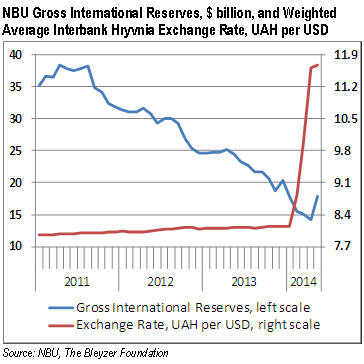
Hryvnia Exchange Rate. The Ukrainian foreign exchange market showed signs of stabilization in May/June after the country started receiving the first tranches of financial aid and the successful presidential elections. As the NBU allowed the Hryvnia to float free, the disbursements of foreign financing had a favorable impact on both NBU gross international reserves and exchange rate developments.
Thus, the Hryvnia has been fluctuating at UAH 11.8-12.0 per USD during April-May and seems to have been trending towards UAH 11.5 per USD since June. We are forecasting that the exchange rate will remain stable at current rates up to the end of 2015, given foreign financing made available and assuming no further hostilities by Russia.
INTERNATIONAL TRADE AND CAPITAL
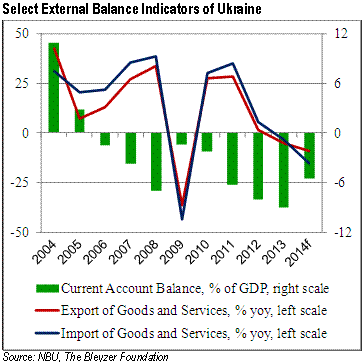
Ukraine’s foreign financing concerns started to ease since the end of April 2014, following the IMF board approval of a $17 billion two-year loan agreement on April 30th and the first tranche disbursement in the amount of $3.2 billion in the first days of May.
As the IMF loan will also unlock financial assistance from other IFIs and individual countries, the sizable financial aid of about $27 billion in total for two years will help rebalance Ukraine’s external position.
In addition, the foreign trade balance turned positive in April and the current account gap is expected to narrow significantly this year to about 5% of GDP.
April’s improvement in the foreign trade balance should be primarily attributed to the sharp drop in imports of goods and services, as exports remained weak. In particular, exports of goods fell by 12% yoy that month, bringing the cumulative decline to 8.3% yoy for January-April.
Suffering from weak foreign demand for metals, particularly due to expectations of a growth slowdown in Russia and Turkey, overseas shipments of these commodities were down by 19.4% yoy and 11% yoy in April and January-April, respectively.
Rising production costs due to Hryvnia depreciation and higher imported energy prices as well as Russia’s annexation of Crimea, where there are a number of large chemical enterprises, hindered both production and exports of chemicals. Exports of chemical products dropped 23.4% yoy in April and 25.3% yoy for the first four months of the year. Tense relations and trade disruptions with Russia exerted a significant toll on production and exports of Ukraine’s machinery and equipment.
Exports of this commodity group sank 22% yoy and 20.4% yoy in April and January-April 2014, respectively. On a positive note, although unrest in eastern Ukraine and the annexation of Crimea hit Ukraine’s transportation infrastructure and traditional export routes, exports of agricultural goods maintained growth at a solid 9% yoy in April.
On the import side, Ukraine’s purchase of foreign goods decreased 30% yoy in April and 21.6% yoy over January-April 2014. Weaker domestic demand amid Hryvnia depreciation, rising domestic inflation, lower fiscal spending and subdued industrial activity led to a 35% yoy decline in non-energy imports in April. Indeed,

shipments of transport vehicles from abroad fell by almost 73% yoy that month; imports of fertilizers and food products were down by 53.5% yoy and 34.3% yoy over the period, respectively.
At the same time, the pace of decline in energy imports in US Dollar terms notably decelerated from about 25% yoy in 1Q 2014 to less than 7% yoy in April. Such deceleration may be explained by higher natural gas imports. Thus, volumes of natural gas imports were up by 77% yoy in April, according to data from Ukrtransgaz, a subsidiary of national natural gas monopoly Naftogaz Ukrainy operating Ukraine’s natural gas pipelines and underground gas storage.
That compares to an almost 14% yoy decline reported for 1Q 2014. At the same time, higher energy imports may be attributed to Russia’s increase in natural gas prices for Ukraine at the beginning of April.
Following the ouster of President Yanukovych, Russia revoked the natural gas price discount granted in December 2013 in exchange for the refusal to sign the Free Trade and Association Agreement with the EU.
In addition, after the annexation of Crimea, Russia restored the export duty on natural gas to Ukraine, which was eliminated in 2010 after Ukraine prolonged the lease of Russia’s Black Sea fleet port in Crimea. As a result, the price for imported natural gas grew from $268.5 per 1000 m3 in 1Q 2014 to $485 per 1000 m3 in April.
Ukraine’s refusal to accept the new gas price led to further accumulation of gas arrears, Russia’s threat to demand pre-payment and to cut natural gas supplies. Despite the EU brokerage, the negotiations failed and Russia cut gas supplies to Ukraine. Both countries filed lawsuits against each other at Stockholm Arbitration Court.
Ukraine still has time until mid-autumn to settle the issue, as it has accumulated 14 billion m3 of natural gas in storages. This should be sufficient to satisfy currently low domestic demand and ensure gas transit to Europe.
Over the first four months of 2014, Ukraine’s financial account position of the Balance-of-Payments remained strained due to high external debt repayments, foreign capital outflow and strong domestic demand for foreign exchange amid high Hryvnia exchange rate volatility.
Indeed, the financial account deficit amounted to $4.4 billion over January-April 2014 amid an almost $1 billion net FDI outflow and high purchases of foreign exchange (the amount of cash outside the banking system of Ukraine grew to $3.5 billion compared to $0.2 billion over the same period last year).
Moreover, the deficit would have been higher if Ukraine had repaid its natural gas arrears. Due to the high financial account deficit, Ukraine’s gross international reserves continued to decline and stood at $14.2 billion as of the end of April. However, on May 7th, reserves grew to $17.3 billion thanks to the first IMF tranche disbursement.
FOOTNOTES:
[1] Own calculations based on State Statistics Service of Ukraine publication ‘Regions of Ukraine, 2012’.
[2] In 1Q 2014, the price of natural gas imports stood at $268.5 per 1000 m3. Although Russia raised the price to $485 per 1000 m3 in April, we assume that resumed shipments of natural gas in reverse order from Europe as well as ongoing negotiations with Russia will result in an average natural gas price reduction to about $370-380 per 1000 m3 in 2014.
ANALYTICAL REPORT: by Olga Pogarska, Edilberto L. Segura
SigmaBleyzer private equity firm & The Bleyzer Foundation (TBF), Kyiv, Ukraine
Published by U.S.-Ukraine Business Council (USUBC), Wash, D.C., Mon, June 23, 2014

